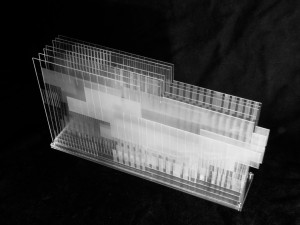Transparency with light
|
The thesis is creating a new kind of phenomenal transparent space with artificial light and use the space to challenge current solid podium typology and literal transparent government headquarter building. WHAT?
The chosen site is located at the government complex in Admiralty. The government headquarter uses large amount of transparent material and the form of a door “symbolizes openness” of the government. But in fact, the reflection of glass and the monolithic facade creates well-controlled boundary condition distinctly separates government and people. The design is to create a podium building which allow people to experience through a large horizontal space with different degree of phenomenal transparency. Podium-tower has been the most common building typology in Hong Kong since 1980s and has grown into larger scale and bulkier solid form. New designed podium would act as a critique to both current podium and government building. Introducing public activities would allow sufficient human flow to go through and encourage civic engagement of the public.
The thesis begins with the work of Colin Rowe, who defined transparencies achieved through quality of substance and quality of organization. Opposite to situation where transparent material allows people to see through space without thoughts, under the concept of phenomenal transparency, a space with all solid wall could still provide interesting space which people has to go through to experience to understand relationship between spaces and planes. Contemporary japanese architects like Kengo Kuma see transparency as connection to the environment and erasing the architecture as an object that is achieved by using light, natural material. SANAA uses simple spatial organization but reflective, transparent material with changing forms or patterns to create illusional spatial experience and achieve different kind of phenomenal transparency. Artificial light is a common media used especially on architectural facade and commercial display in modern days. It is frequently manipulated in art installation but skills are rarely used in changing spatial experience. In this thesis, instead of changing material, artificial light would be studied and new methods would be applied to create space with phenomenal transparency. HOW The thesis would involve experimental models testing stratification of planes of current site and models studying how artificial light could change space. BIBLIOGRAPHY 1. Rowe, Colin, and Robert Slutzky. Transparency : Literal and Phenomenal . Basel: Birkhäuser Verlag, 1997. Print. |









